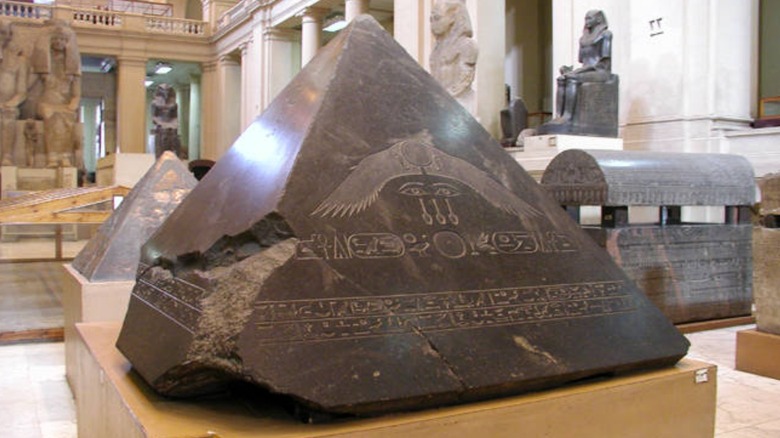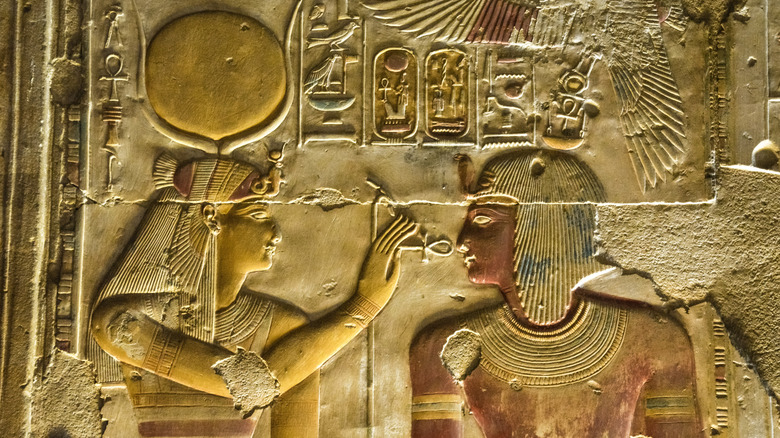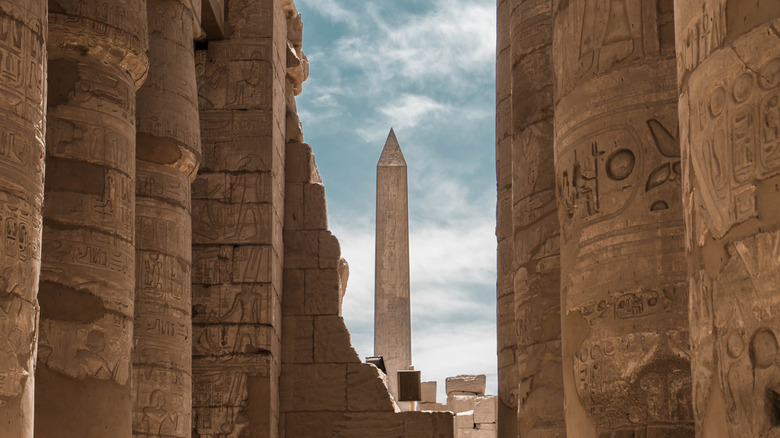The Unsolved Mystery Of The Ancient Egyptian Benben Stone
Ancient Egypt is definitely a favorite time-lost locale for ancient astronaut theorists, mystics, and general lovers of the obscure and bizarre. After all, we've got curse-wielding mummies, dudes with dog heads (Anubis), feathers being weighed against the wrongs of souls (by Osiris), semi-deified figures like Cleopatra, exotic-looking artifacts like the Sphinx, and of course, the crème de la crème of human wonders and architectural genius: The Pyramids at Giza. The pyramids themselves, particularly the Great Pyramid built by Pharaoh Khufu (2609 – 2584 BCE), are an endless wellspring of tales related to astronomical links to the Orion Belt, "indestructible" pharaonic bodies enshrined in the sky as stars, and even the pyramids being ancient electricity generators because of something-something quartz crystals.
Well, in case you've missed it, there's one more artifact we can add to the mix: the Benben Stone. And yes, you should feel completely free to say "Benben Stone" out loud just for fun.
"Benben" can refer to two separate types of objects, as Ancient Origins overviews. We've got the mythological, original Benben of the ancient Egyptian city of Heliopolis in "Lower Egypt," the northern part of the country near the Nile delta. Heliopolis, as its Greek prefix "helio-" indicates, was the center of sun worship in ancient Egypt, home to god the Ra (also spelled Re). Benben Stones are also "pyramidions," capstones at the top of pyramids or obelisks. It makes sense that the pyramidions were built in imitation of some original object at Heliopolis.
An artifact at Heliopolis from the beginning of time
Our understanding of the mythological Benben Stone originates in the Egyptian Book of the Dead, a cheat sheet of spells, rituals, and rites for the dead to use to navigate the afterlife. As World History says, the Book of the Dead was based on tomb paintings as far back as Egypt's Third Dynasty (2670 – 2613 BCE), but weren't written down until 700 to 800 years later during the 12th Dynasty (1991 – 1802 BCE). Papyri were buried with the dead, no two exactly alike, and by 1570 – 1069 BCE, families had custom-made books written that were tailored to the specific afterlife needs of deceased family members.
All in all, such beliefs show how important (and real) the afterlife was to the ancient Egyptians. In many ways, life after death was more significant than life. Consider this line from the Book of the Dead, per Vintage News, "O Atum-Khoprer, you became high on the height, you rose up as the Benben-Stone in the Mansion of the Phoenix at On." Atum, as Ancient Egypt Online summarizes, was the first being of the cosmos who rose from Nun, the primordial emptiness, and from him came life (Shu) and death (Tefnut). The Benben Stone was described as some artifact from the origin of the universe, enshrined in the sanctuary of Atum in Heliopolis, as Symbol Sage explains. Some think the Benben Stone is the origin for all of ancient Egypt's pyramidal designs.
Curio, ancient meteorite, or Ark of the Covenant
As for the lesser Benben Stones, the ones placed on the tips of pyramids and obelisks, we can check out a visit Mr. "It was Aliens" himself, Giorgio A. Tsoukalos, made to the pyramidoid of the Pyramid of Amenemhet III at Dahshur, now on display at the Egyptian Museum in Cairo. You can even watch Mr. Tsoukalos bust out an honest-to-goodness, totally unscripted, old-timey magnifying glass and comb it over the surface of the gray granite stone. As Ancient Egypt Online speculates, this particular stone was likely defaced during the reign of Akhenaten (1353 – 1336 BCE), who tried to convert Egypt to monotheism. Many such stones have been recovered, each one unique and inscribed with ornate religious iconography honor of a particular god or goddess.
Tales have followed the Benben Stones for literal millennia. The original was said to be housed in a temple in Heliopolis translated as "House of the Benben," per Ancient Origins. Per Symbol Sage, its description has drawn comparisons to the Ark of the Covenant, and also been likened to the Stone of Destiny in Scotland used in coronations of English kings and queens. This draws further connections to Arthurian legend and the Holy Grail, which loops back around to the Ark of the Covenant, Knights Templar, and lots of other corkboard-and-string stuff. Yet other sites, such as this University College London blog, suggest that the original Benben Stone was an iron-nickel meteorite from 29 million years ago.


